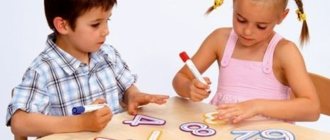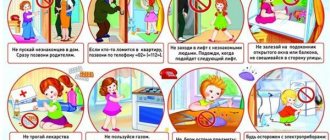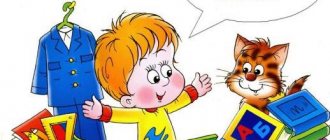As we get older, we know that when crossing the road, it is important to look both ways first, some strangers can be talked to, and first opinions can sometimes be deceiving.
Children don’t know this, that’s why they are children - in the process of growing up, every young member of society learns responsibility. You need to carry it for yourself, and this means monitoring your own behavior and not forgetting about other people.
Today Tlum.Ru will tell you what is important for every parent to teach a child: rules of conduct on the street, in transport, and tips on what else to do in an unfamiliar situation.
An important clarification: don’t let your anxiety interfere with your child’s normal growth, so you read the news and don’t let him go anywhere until he reaches adulthood, but what next? We recommend a cool head and maximum adequacy, try not to rush from one extreme to another.
Dangers on the street
No. 1: Roadway and road users
The machine is not as fragile as human bones. Nobody canceled the braking distance. It is better to avoid a disaster than to try to find ways to solve the problem. All this concerns the presence of children near the roadway.
Your task is to explain that playing near the road, crossing it in the wrong place or running a red light is a bad idea. Extremely bad. Teach your child to look both ways in any situation - when you cross the road together or when he does it without you, in a crowded place or not, with or without a controlled crossing.
#2: Friendly Strangers
“Do you want some candy?”, “Masha from the second “B” is my sister”, “I have a dog here, I’m looking for friends for her” - these and a million other variations of obviously cute phrases should not endear a child to a stranger.
Teach: you can’t carry on a conversation, you can’t take gifts, you can’t get into someone else’s car, you can’t go anywhere with a stranger, and you can’t be alone with him. Inspire your child that you will always introduce all your friends, acquaintances or parents of other schoolchildren (or kindergarteners) yourself. All others should a priori be considered, at best, liars.
A distance of one and a half meters and the desirable presence of an obstacle between the child and the stranger will give a head start in case of escape. Remember: you can't turn your back on strangers.
What else can't you do? You may be surprised, but children should not help strangers on the street - this requires calling an adult.
When entering the entrance: it is not recommended to linger - this way, anyone else can come in next without a key; You shouldn’t run into the entrance after someone; ride in an elevator with strangers (a similar point can be safely recommended to adults, because often one or two minutes will not make a difference in time). Loneliness in this case is a defense mechanism in every sense. Teach your child not to listen to music with headphones at full volume - this will help to be aware of the situation around him.
No. 3: Animals
Going to the store, buying food and feeding that unfortunate couple of cats that are always hiding in the basement of your house is one thing. Teasing street dogs that have managed to form a pack is completely different; no amount of thrill is worth the possibility of becoming disabled or contracting rabies through a bite.
Set your child up for calm behavior on the street; let him, if he has such a craving for animals, learn to first ask the owner if he can pet the animal. If you refuse, you shouldn’t hang your nose; there will be someone more accommodating.
Poisonous plants
In our latitudes there grow many seemingly harmless plants that can be dangerous not only for a child, but even for an adult. Some of them are completely neutral until they are eaten - such dangerous plants for children include wolfberry, lily of the valley, with its red fruits, which are so attractive to children. A child should not be allowed to lick the yellow poisonous juice of celandine or taste the flowers of belladonna and henbane. And the beautiful trunks, leaves and umbrellas of hogweed are dangerous even with ordinary touch - they cause severe, long-lasting and painful burns.
As for nettles, touching them is very unpleasant and the child will remember such contact the first time. Especially if you show what nettle looks like. However, a burn from nettle leaves does not pose any particular danger to a child, but it is still better to do without it.
How to avoid: no matter how old the child is, tell him that in the forest, park, or even in the yard you should never put berries in your mouth without showing them to an adult. Before settling down for a picnic, inspect the area and let children go to places of particular danger.
Dangers in transport
No. 1: Direct transport
No games on the edge of the platform or at the bus stop, it is important to maintain distance and do not forget that other people also use transport - who may stumble, stumble, get distracted, or even deliberately try to create an emergency situation with someone else's participation. Taking care of yourself and being careful in this case will not be enough; let the child watch the others.
#2: People
You are at work, it’s time for the child to go to school, which means that, at best, you will need to use the bus, and at worst (figuratively speaking) also the metro or even trains. Teach your child not to get carried away by thoughts, games, books or music. The same fight may break out in the cabin or carriage, and it is better to have time to dodge the participants.
The ways of talking with annoying people may not be varied; here it is important to use a good voice, so that a boy or girl can say “Leave me alone” loudly, clearly, loudly and without undue modesty, and the people around them notice the suspicious citizen.
Teach your child not to leave his pockets open, and to take off his backpack during long journeys from point A to point B - this way he will irritate other people less, and attempts to check if there is something interesting there will be minimal from the very beginning.
There are other types of problems that the child will have to solve first; we remind you that he is alone, without your accompaniment, and must be aware of the risks.
What is important to teach a child?
A preschooler should know: what his and his parents’ names are, and what address everyone lives at. Ideally, you would also remember the phone number of mom, dad or any other close relative, but this depends on the child. Lost kids either loudly announce to the world that they are alone, or they go silent. It is important to attract as much attention as possible.
What parents need to do: make sure that the baby distinguishes their faces from the faces of other people. If a stranger approaches, it is important to inform everyone that this is not mom, not dad, or even great-aunt. Make sure you have coordinates for communication - put the appropriate paper (you can even laminated it) with contacts in your child’s pocket. Now they sell clothes with a sewn-in place for contact, do not be lazy to fill it out and update it periodically.
The schoolchild should know: everything is the same and the cell number, as a rule, schoolchildren are already better at memorizing than preschoolers. At the same time, the student should not be afraid to ask for help - police officers, mothers with children, store clerks. In the Moscow metro, special sticker marks have been installed for lost people, indicating that at this point you can stop and wait for the arrival of a police officer or station duty officer, who will help reunite with their parents.
There don’t seem to be many rules, but in reality everything is more complicated. It is worth striving for a trusting relationship between parents and children. Does your child understand that you are not taking care of him for show, but are really worried about his safety? Great, then the following points will be easier to remember:
- Before leaving home, let the child warn his parents where he is going, with whom and for how long he will be away. Are you planning to return later? Arrange a meeting - this will make everyone calmer;
- the child should not tell strangers anything about himself - where he is going, what his name is (it is not forbidden to come up with a fictitious name). It is important to tell especially annoying people in time that their attention is unpleasant;
- if a suspicious company appears ahead, it is better to move to another street, adults often do this, and there is no shame in children either;
- After the doorbell rings, the child is asked to go out and help reach the neighbors, what should I do? Ignore, or better yet, write to the neighbors themselves (if you have contact), try to remember the face - through the peephole, don’t open the door! Reporting that there are no adults is also not worth it;
- had to walk along the road? It doesn’t matter - the main thing is that the transport is moving towards, and not in the direction of travel;
- when entering the elevator, make sure that there is no one on the landing;
- in the elevator you don’t need to turn your back to a stranger, so you can see what he’s doing, where the dispatcher’s button is - everyone knows;
- The desire to wait until all the neighbors have left the landing is not just in adults; in this way we ensure our safety when we ourselves want to go out - let no one breathe down our backs;
- the “fight or flight” state is a normal reaction; if a child cannot physically fight back and doubts his own strength, then let him use speed and run away from trouble.
The safety of the child is in his hands and in the hands of his parents. The better the preparation for an atypical situation, the less stress you will experience. Regarding safety rules, there is more than one training manual from which it is easy to learn a lesson. For general peace of mind, there are sports sections and self-defense courses, just please coordinate their attendance with your child, in case he is not yet ready to do such things and it is easier to turn to other, less aggressive advice that we have already given.
Be careful and do not take the danger to your own life as a joke. Anything can happen. We wish everyone safety!
To read more useful materials for parents, subscribe to our Yandex.Zen channel. We also launched Telegram - join if this format is more convenient for you.
Rules of behavior on the street
Safety rules help you avoid becoming a victim of an accident. Therefore, parents must take care that the child knows how to use them.
Safety on the street
Among other topics, special attention should be paid to the following issues:
- Traffic rules
- How to behave if you are lost.
- Conversation with a stranger in an elevator.
- Ice in winter.
- Spring and winter are a dangerous time of year.
How to teach safe behavior to children
Developing street etiquette skills should begin in childhood.
You can introduce preschoolers to the essence of problems in a playful form, acting out acute situations with their favorite toys. Imishka dolls can be passengers in transport, or cross a toy street.
Real examples are equally important. If parents respond kindly and affably to other people, dad helps mom put on her coat, holds the door and offers his hand, the child will do the same without unnecessary reminders.
Schoolchildren willingly participate in conversations and discussions of important issues. They are able to prepare and give an interesting presentation on a given topic for class.
Transport safety
Many children have to travel part of the way home in public transport. Parents can make a small reminder for their offspring:
- Names of stops.
- Route numbers and types of transport.
- Schedule .
Subway behavior
Here children must strictly follow the established order:
- Have a travel document;
- Understand how passage through the turnstile is carried out;
- Don't run up the escalator;
- Do not go beyond the waiting platform;
- Do not try to squeeze through the closing doors of the carriage.
Rules of conduct in ground transport
On buses and minibuses, you need to take a comfortable position and have reliable support that will prevent you from falling during the jolts of the transport. You can’t sleep and miss the required stop.
Generally accepted norms of order help you feel confident even when there are crowds of people: in shops, cafes, sports centers, etc.
CHILDREN PASSENGERS
In public transport:
It seems that there is nothing difficult here - the child got on the bus, sat down and drove off, however, passengers also need to follow the Rules.
The danger of traveling in public transport is usually associated with sudden braking, for which passengers are always unprepared.
Parents who allow their children to travel independently on public transport need to explain to their children the following rules:
1) It is safe to wait for public transport only at the landing site, and if there is none, then on the sidewalk or side of the road, but in any case, away from the roadway.
2) Entry into a minibus can only be done after the vehicle has come to a complete stop.
3) While in public transport, you must hold firmly to the handrails.
4) You should give way to elderly and sick people - this is not only a rule of politeness, but also safety - after all, it is more difficult for them to react to sudden braking and stay on their feet.
5) It is prohibited to distract the driver from driving, or to open the doors of the vehicle while it is moving.
6) You should prepare for the exit in advance so that you don’t have to rush. When leaving the transport, you should not rush either. Especially if you need to cross to the other side of the road. It is necessary to clearly understand: you can only cross the roadway at a pedestrian crossing.









